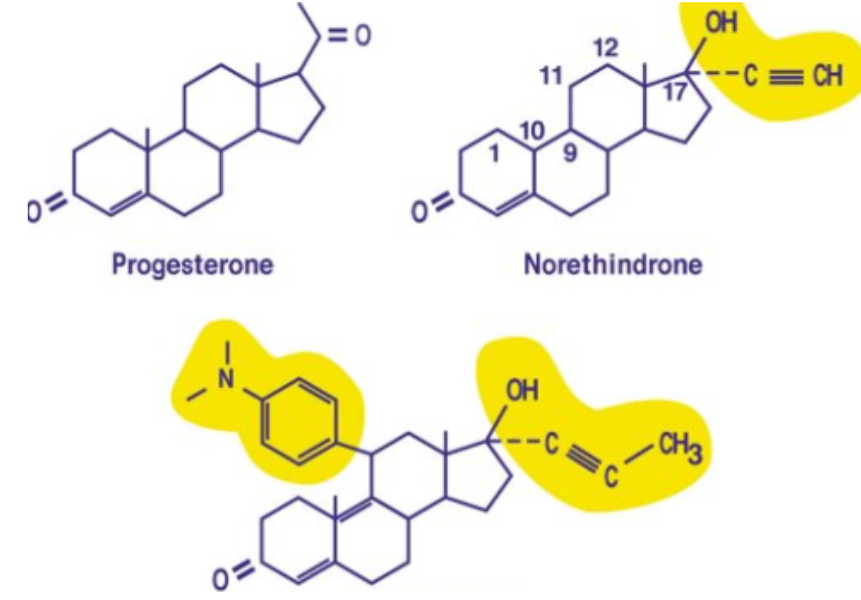🔍 Mifepristone – an antagonist of progesterone, was invented in the late 1980s and has been registered for 30 years as a medication for inducing (early) abortions in combination with misoprostol.
💊 It is effective as a morning-after pill and for the treatment of fibroids with long-term daily use of 25 or 50 mg (registered for this indication in China, India, Georgia, Moldova, Russia). It is also registered for long-term use with very high daily doses (up to 1200 mg) for the treatment of Cushing’s syndrome in the USA (Korlym) since 2012. The main objective of the proposed study is to prove that long-term use, once a week, of mifepristone 50 mg has a Pearl Index lower than 1 (less than 1 unwanted pregnancy per 100 woman-years of exposure) and is safe.
🚫 Disadvantages of hormonal contraceptives: Research has shown that the use of hormonal contraception, especially among adolescents, is associated with subsequent antidepressant use and with an initial diagnosis of depression with a relative risk of 1.7 at six months after starting hormonal contraceptive use. In addition, hormonal contraceptives are associated with approximately 1 additional breast cancer for every 7690 women using hormonal contraception for 1 year. Alternative contraceptives, such as IUDs (Intrauterine Devices), also have other health risks; when a woman becomes pregnant while using an IUD, the risk of it being an ectopic pregnancy approaches 50%. Approximately 1 out of 5800 users of the Mirena IUD and 1 out of 1200 users of the copper IUD will have an ectopic pregnancy.
💉 Bleeding problems occur in >10% of women using Oral Contraceptives, Implants, and Mirena, which is often a reason to discontinue this method.
🔄 Method dissatisfaction is the most common reason for discontinuation of contraceptive use, and pill users have a probability of 25%, 38%, and 46% to discontinue use by the end of the first, second, and third year, respectively.
👍 The best solution is – Mifepristone!
🔬 The contraceptive characteristics of mifepristone have long been recognized. Since it is not associated with estrogen-related adverse effects that come with hormonal contraceptives (weight gain, loss of libido, depression, headaches, increased risk of venous thromboembolism), it is likely to be more acceptable. The contraceptive efficacy of mifepristone is linked to the inhibition of ovulation, as well as its effect on endometrial development. Several studies analyzing different daily or weekly low doses of 2 and 5 mg and weekly doses of 10 mg of mifepristone have found them insufficient to prevent pregnancy.
🩺 Contraceptive characteristics of mifepristone: Mifepristone – A Novel Contraceptive Anti-hormonal. Mifepristone is a well-researched medication with a very high safety profile. In other studies, it has been found that mifepristone 25 and 50 mg once a week is highly effective in preventing pregnancy. The group receiving 50 mg weekly showed more amenorrhea, suggesting a greater effect on the endometrium, which would correspond to higher efficacy and a potential treatment for women with bleeding problems. Additionally, fewer women ovulated after receiving 50 mg once a week.
🎯 Secondary objective is to prove that mifepristone 50 mg is acceptable and has a better side effect profile than oral hormonal contraceptives and progesterone-containing IUDs. We expect this method to be preferred by women due to its ease of use, absence of bleeding problems, and side effects.
🔍 Investigation schema: Oral administration of mifepristone 50 mg (Gynestril) once a week for 13 menstrual cycles.
📑 For more detailed information, please refer to the protocol.
📞 Contact for the representative/sponsor in the Republic of Moldova:
Dr. Rodica Comendant,
Lecturer, Director of CIDSR.
Visit CIDSR website for more information.





